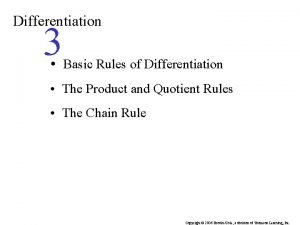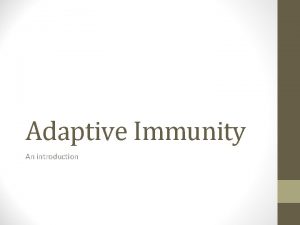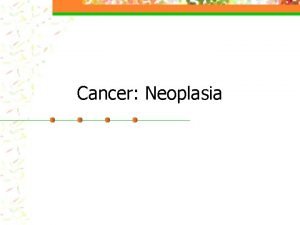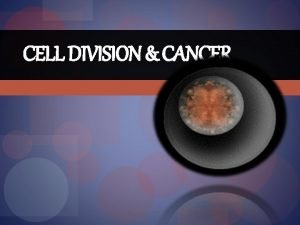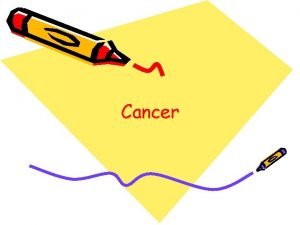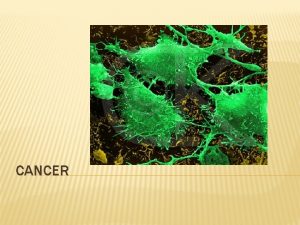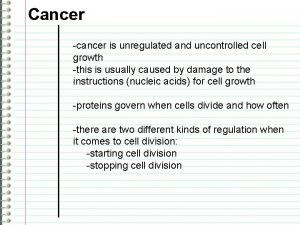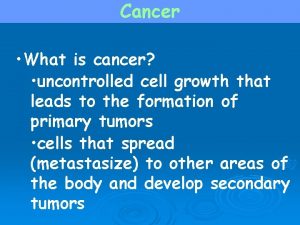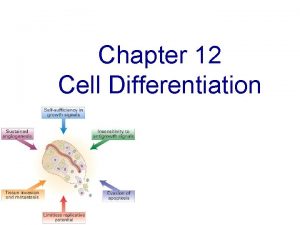Chapter 18 Cancer Uncontrolled Cell Division and Differentiation
















- Slides: 16

Chapter 18 Cancer: Uncontrolled Cell Division and Differentiation Pancreatic Cancer Cell Copyright © 2009 Pearson Education, Inc. http: //www. webmd. com/cancer/pancreatic-cancer/slideshow-pancreatic-cancer-overview

Tumors § Benign § Remain in one location § Single, well-defined mass § May be surrounded by connective tissue § Cancerous § Abnormal cell structure; may appear undifferentiated § May spread § Edge of tumor not clearly defined Copyright © 2009 Pearson Education, Inc.

Malignant Tumor Development Cancer 1 Cancer 2 Copyright © 2009 Pearson Education, Inc. Figure 18. 2

Cancerous Cells: Lose Control Over Cell Functions § Dysplasia § Abnormal change in cell structure § In situ cancer § Malignant tumor in only one place § Metastases § Secondary, malignant tumors at other locations Copyright © 2009 Pearson Education, Inc.

How Cancer Develops § Mutated or damaged genes § Proto-oncogenes § Normal regulatory genes § Promote cell growth, differentiation, division, and adhesion § Oncogenes § Mutated or damaged proto-oncogenes § Tumor suppressor genes § Regulatory genes repress cell growth, division, differentiation, and adhesion § P 53 prevents damaged or stressed cells from dividing § P 53 may be turned off, damaged, or mutated in cancers p 53 Copyright © 2009 Pearson Education, Inc.

Factors Contributing to Cancer § Viruses and bacteria § HPV § Hepatitis B and C § HIV § Helicobacter pylori § Chemicals in the environment § Tobacco § Radiation § Dietary factors § Animal fats, red meat increase risk § Fruits and veggies decrease risk § Internal Factors § Free Radicals antioxidants (Vitamins A, C, and E) Copyright © 2009 Pearson Education, Inc.

Advances in Diagnosis: Early Detection § Tumor imaging § X-rays, PET, MRI § Genetic testing controversial § Identify mutated genes § Privacy and treatment issues § Enzyme tests for cancer markers § Telomerase activity § Screening large numbers of people Copyright © 2009 Pearson Education, Inc.

Cancer Treatments § Conventional treatments § Surgery § Radiation § Chemotherapy § Delivery mechanisms § Coated metal beads § Light-sensitive drugs Copyright © 2009 Pearson Education, Inc.

Cancer Treatments § Immunotherapy § Promotes the immune response § Starving cancers § Inhibits angiogenesis § Molecular treatments § Target oncogenes Nanotechnology Copyright © 2009 Pearson Education, Inc.

Ten Most Common Cancers Copyright © 2009 Pearson Education, Inc. Table 18. 3

Most Common Cancers § Skin cancer § Three major types § Basal cell carcinoma § Squamous cell carcinoma § Melanoma http: //www. sciencelearn. org. nz/contexts/you_me_and_uv/sci_media/images/basal_cell_carcinoma http: //www. aurorahealthcare. org/healthgate/images/si 55551327. jpg http: //www. nlm. nih. gov/medlineplus/ency/imagepages/1707. htm Copyright © 2009 Pearson Education, Inc.

Most Common Cancers ABCD for detection of skin cancer Copyright © 2009 Pearson Education, Inc. http: //myhealth. ucsd. edu/library/healthguide/en-us/support/topic. asp? hwid=aa 78799

Most Common Cancers § Lung cancer § Smoking is the leading risk factor § Early detection is the best chance for survival § 1 year survival for all stages is 41% § 5 year survival is 15% Copyright © 2009 Pearson Education, Inc.

Most Common Cancers § Cancer of the uterus § Includes cervical cancer and cancer of the endometrium § Breast cancer § Early detection is crucial for survival § Prostate cancer § Most common after age 50 § Grows extremely slowly 5 year survival rate is 99% Copyright © 2009 Pearson Education, Inc.

Most Common Cancers § Cancer of the colon or rectum § Tests can detect them early § Leukemia § Chemotherapy often effective Copyright © 2009 Pearson Education, Inc.

Most Cancers Are Preventable § Know family history § Get regular medical screenings § Learn self-examination techniques § Avoid direct sunlight 10 a. m. to 4 p. m. , sunlamps, and tanning salons § Watch diet and weight § Don’t smoke § Drink in moderation, if at all § Be informed Copyright © 2009 Pearson Education, Inc.
 Importance of mitosis
Importance of mitosis Section 10-2 cell division
Section 10-2 cell division Cell cycle and cell division
Cell cycle and cell division Cell cycle phases
Cell cycle phases Section 8-2 cell division
Section 8-2 cell division Basic derivative rules
Basic derivative rules Differentiation division rule
Differentiation division rule Derivative chain rule
Derivative chain rule Chapter 4 cell theory and cell study
Chapter 4 cell theory and cell study Differentiation of t cell
Differentiation of t cell Controlled and uncontrolled observation example
Controlled and uncontrolled observation example Controlled uncontrolled and blind intersections
Controlled uncontrolled and blind intersections 369 times 2
369 times 2 Terms of division
Terms of division Synthetic devision
Synthetic devision Dividing polynomials synthetic division
Dividing polynomials synthetic division Chapter 24 the immune and lymphatic systems and cancer
Chapter 24 the immune and lymphatic systems and cancer







